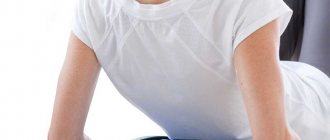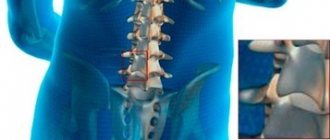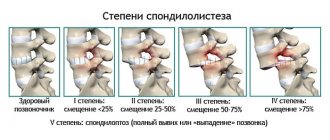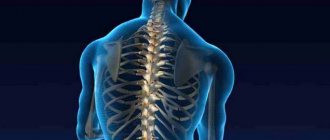Back pain is described in different ways: acute, nagging, excruciating, burning, paroxysmal, etc. The reasons that cause it also vary. Although, frankly speaking, most of us don’t bother looking for them. If you get sick, you need to apply heat and take a pill (give an injection).
But it's not that simple. Back pain can be either a consequence of an easily removable (if you are in the hands of a good specialist) muscle tension, or a manifestation of a very serious disease that needs immediate treatment. And the sooner a person starts therapy, the greater the chance of success.
Only a doctor can correctly determine the cause and nature of the pathology and prescribe adequate complex therapy! Self-medication for back pain is ineffective and dangerous!
What is radiculopathy
Against the background of lumbar osteochondrosis, a disease such as radiculopathy of the lumbosacral spine very often develops.
This is a clinical syndrome that occurs due to compression and damage to the nerve roots. A synonym for radiculopathy is radiculitis. Radiculitis (radiculopathy, from the Latin radicula - root) is a disease of the human peripheral nervous system that occurs as a result of damage, inflammation or pinching of the spinal nerve roots.
Radiculitis is a widespread disease, it affects more than 10% of the population of our planet over 40-50 years of age, and in the last decade, radiculitis has become younger, occurring in the young age group from 25 to 35 years old, people involved in professional sports, as well as those who are especially susceptible, are especially susceptible. who sits at a computer or driving a car for a long time.
List of drugs for radiculitis
Below is a list of the most popular remedies for the treatment of radiculitis.
Diclofenac
Diclofenac is a non-steroidal anti-inflammatory drug
It is a nonsteroidal anti-inflammatory drug that is taken orally or administered intravenously. Prevents the spread of the inflammatory process, relieves pain. Diclofenac is a potent drug and is taken only as prescribed by a doctor.
Movalis
Movalis is also from the NSAID group
It is a non-steroidal anti-inflammatory drug, a modern development of pharmaceutical companies . Taking Movalis reduces local body temperature, the increase in which is caused by inflammation of the nerve roots, and relieves pain for a long time (the tablets last from 4 to 10 hours).
Nimesulide
Nimesulide is prescribed for inflammation of the nerve roots
Another NSAID drug that is prescribed for inflammation of the nerve roots . Nimesulide contains components that can relieve areas of pain. Thanks to this, after taking the drug, the discomfort decreases and passes over time. The tablets have antipyretic properties, which allows you to reduce local body temperature.
Ketoprofen
The effect of Ketoprofen lasts up to 12 hours
It is a well-known pain reliever whose effect lasts up to 12 hours. The drug is prescribed for pain and severe local swelling, which is a consequence of inflammation in the nerve roots.
Analgin
Analgin has a pronounced analgesic effect
Has a pronounced analgesic effect . Suppresses biologically active substances that cause pain. Reduces local body temperature.
Mydocalm
Mydocalm is intended to relieve muscle spasms
Refers to muscle relaxants , because can relieve muscle spasms. The drug acts directly on the brain and central nervous system, blocking the area responsible for pain. The tablets also relieve local muscle spasms, which cause pain and swelling in the affected area.
Causes of radiculitis
The cause of the development of radiculitis is pathological processes occurring in the spine, namely:
- Degenerative-dystrophic processes - osteochondrosis and its complications: protrusion and herniation of intervertebral discs
- Malformations of the musculoskeletal system, accompanied by changes in muscle tone
- Poor posture, curvature of the spine - scoliosis
- Incorrect distribution of physical stress on the spinal column during a person’s professional activity (when driving a car, office workers and loaders - when they stay in one position for a long time, loaders)
- A sedentary lifestyle, in which disturbances in the blood supply to the muscles of the lumbar region gradually increase
- Improper drinking regime throughout the day and for several months
- Deficiency of vitamins and minerals leads to osteoporosis and trophic lesions of the nerve fiber
- Tuberculosis, osteomyelitis, chronic syphilis and other types of infectious lesions of the spinal cord
- Regular injuries to the vertebrae and surrounding soft tissues (impacts, sharp twists, compression when jumping, sprains of the ligaments)
- Overweight with obesity of 1-2 degrees and the presence of bad habits such as smoking, abuse of tea, coffee and alcoholic beverages
Symptoms of radiculopathy
Doctors use the term radiculitis (radiculopathy) to describe a set of symptoms that appear when there is pressure on the roots of the spinal cord (which is a bundle of nerve fibers emanating from the spinal cord). However, radiculitis (radiculopathy) is not an independent disease, but only a complex of symptoms including pain, muscle weakness and sensory disturbances, which originate in the spine and go to the limbs. The human spine is divided into five sections and sciatica (radiculopathy) most often occurs in the cervical thoracic and lumbar spine. 31 pairs of roots arise from a long spinal cord in the rather narrow spinal canal of the spine. Various reasons can reduce the space where the roots are located and put compression on them - this is a disc herniation or protrusion, stenosis, tumor, infectious process, osteophyte. Despite all the variability of symptoms, the most common symptoms are the following:
- Pain (discomfort) from dull and intermittent to constant and debilitating with irradiation. Pain (as a protective factor in the body) indicates that there is a damaging effect on nerve fibers.
- Impaired sensitivity. It should be noted that the spine is a rather complex structure. We unconsciously carry out a huge number of movements, and this happens automatically. But in order for the movements to be harmonious, it is necessary that there is feedback from the brain to the muscles and sensory receptors. When the roots are compressed, the conduction of impulses in both directions is disrupted. Accordingly, both sensitivity (numbness, burning, tingling) and impulse transmission to the muscles are impaired.
- Muscle weakness. Sometimes muscle weakness occurs in isolation (with isolated compression of motor neurons). For normal muscle functioning, two-way communication is necessary, both with the spinal cord and the brain. When the root is compressed (by a disc herniation, osteophyte or something else), the supply of impulses is interrupted and the muscle stops working normally. With prolonged disruption of the normal conduction of impulses, muscle atrophy or even flaccid paresis occurs.
Symptoms of radiculitis
The first manifestations and main permanent symptoms of radiculitis of the lumbosacral spine are pain, impaired sensitivity and muscle weakness.
The affected area corresponds to the innervation zone. Depending on the affected area, pain can be observed in the lumbar and gluteal regions, the posterolateral and anterior part of the thigh, along the anterior outer surface of the lower leg, on the dorsum of the foot, big toe, in the calf muscle, in the area of the outer ankle and heel.
Lumbosacral radiculitis is often chronic, with acute relapses. Lumbosacral radiculitis is characterized by increased pain when the body suddenly changes from a horizontal to a vertical position or vice versa, as well as when engaging in an active lifestyle (sports, walks, fitness classes).
Exacerbation of pain syndrome in radiculopathy of the lumbosacral region is observed when the interradicular nerve is compressed by an intervertebral hernia.
According to the types of radiculopathy of the lumbosacral spine, there are:
- Lumbago (lumbodynia) is acute pain in the lower back during sudden physical exertion, and also provoked by overheating or hypothermia of the body. The painful attack itself can last in different ways: from several minutes to several hours and even days. The main cause of this type of radiculopathy is muscle strain in the lumbar region, intervertebral hernia or displacement of the vertebrae relative to each other.
- Sciatica (sciatica) - with this type of radiculitis, pain is localized in the buttock, on the back of the thigh and lower leg and can reach the foot. Sometimes, in addition to pain, muscle weakness is noted. This is due to damage or irritation to the sciatic nerve, the largest nerve in the body. The pain with sciatica is shooting, like an electric shock; burning, tingling, “pins and needles” and numbness are also possible at the same time. Pain of varying degrees of intensity is possible: from mild to very intense, such that the patient cannot sleep, sit, stand, walk, bend or turn.
- Lumboischialgia is lower back pain radiating to the leg or legs. With this type of radiculitis, the pain spreads mainly along the buttock and along the posterior surface of the leg, without reaching the toes; most often it is an aching, burning, growing pain.
Treatment of radiculitis
Symptoms and treatment methods for lumbar radiculitis depend on the severity. In the acute stage, doctors prescribe complex therapy. It is necessary to treat the pain syndrome, which can be very severe, so not every remedy can cope with it. In addition, you need to reduce inflammation, treat swelling, and relax tight muscles. Doctors also prescribe ointments, gels or other products. For unbearable, girdling pain, block anesthesia is used.
Medicines
It is important to know that there are a lot of remedies for the treatment of lumbar radiculitis. Each drug must be used in strict sequence, depending on the symptoms of the disease. Many medications require precise dosage and have contraindications. Treatment of radiculitis with folk remedies should be agreed with your doctor.
Analgesic drugs
The very first task of therapy for radiculitis is treatment with analgesics that can cope with severe pain that interferes with the patient’s normal life. The most commonly used are Metamizole, Analgin, Baralgin, Pyramein, Butadione, Ketorol. Depending on the patient’s condition, treatment can be done with drugs in the form of tablets or injections.
Nonsteroidal anti-inflammatory drugs
Non-steroids do an excellent job of treating inflammation of the lower back, relieve swelling and help treat pain and spasms, thereby speeding up the treatment of radiculitis at home. They are often prescribed not only in the form of tablets or injections, but also ointments. Usually prescribed are Diclofenac, Ortofen, Voltaren, Ibuprofen.
It is important to remember that these treatment medications should be taken for a short period of time as they have side effects.
Steroid drugs
Since treatment of lumbar radiculitis at home with non-steroidal drugs is not always effective, glucocorticoids are prescribed, which help when signs of inflammatory reactions appear. Medopred and Methylprednisolone are used more often. If necessary, the dosage is gradually increased or decreased.
Muscle relaxants
Medicines to relax muscle tone are prescribed by a doctor in accordance with the course of the disease. Sirdalud, Mydocalm, Baksolan help treat the disease. After a course of treatment, the patient’s pain intensity decreases, lower back stiffness decreases, and general condition improves.
Chondroprotectors
In order to increase metabolism in the intervertebral discs of the lower back and treat the disease, medical experts recommend taking the following drugs: Chondroitin, Dona, Structum, Chondroxit. They are used in courses of 4 months, with a two-month break between treatment cycles.
Ointments and compresses for radiculitis
How to treat lumbar radiculitis at home? Ointments with a warming and analgesic effect give a very good effect. They are prescribed after treatment of acute pain syndrome. Ointments such as Capsicam, Viprosal, Finalgon and other products whose active ingredient is snake venom are often prescribed. Compresses with Menovazin, formic alcohol, and tincture of hot pepper help treat inflammation and reduce pain.
Traditional methods
Before treating lumbar radiculitis at home, you need to consult with your doctor, which will help avoid side effects and allergic reactions.
Excellent help to treat swelling and pain in muscle tissue:
- home rubs;
- lotions;
- applications.
In addition, compresses with burdock leaves, previously soaked in boiling water, can be applied to the lumbar area for treatment. Decoctions of linden leaves, nettles, elderberry and chamomile flowers, and hop cones help relieve inflammation and help treat.
Garlic
How to cure lumbar radiculitis at home with a compress with garlic? You need to take several peeled heads of garlic and boil for a minute in boiling water. Then take it out and crush it into a paste, which you then place in the middle of the napkin. Keep the treatment compress on the lower back for 12 or 24 hours. Repeat in a day.
Beeswax
Wax reduces symptoms, and home treatment for sciatica with folk remedies helps eliminate pain and inflammatory reactions. First, the lower back is lubricated with vegetable oil, and an application of wax, heated to a liquid state and slightly cooled, is carefully applied. The treatment area is covered with foil and a warm scarf.
Wool belts
How to treat lumbar radiculitis using a belt? Products made from the wool of dogs, sheep, camels:
- relieve pain and reduce pain and inflammation;
- wool activates local blood circulation;
- prevents and treats muscle spasms.
Black radish
Black radish applications are widely used to treat lumbar radiculitis. The vegetable is chopped, 2 tbsp is added to the mixture. l. honey and a little vodka. To treat and protect against burns, the lower back is lubricated with oil and covered with gauze. The composition is applied to gauze, then covered with film and wrapped.
Bath
Hot and humid steam helps relieve muscle spasms, reduce pain and alleviate the patient's condition during remission. During the acute period, it is not recommended to treat the disease with a bath.
Potato
How to treat radiculitis with potatoes? Crush the hot cooked tubers and place them on your lower back, greased with vegetable oil, then wrap them well.
Bodyaga and camphor
For treatment, you need to mix 100 grams of camphor powder and bodyagi, pour into butter, brought to a boil. After this, mix and cool. Treat by rubbing into the affected area.
Snow therapy
The snow is wrapped in a napkin, after which it must be applied to the lower back for 5-7 minutes. Then the back is wrapped warmly.
Physiotherapy
Exercise therapy is prescribed to help treat a patient during remission. Gymnastics helps treat radiculitis, eliminates congestion, normalizes the movement of blood and lymph in tissues, and reduces pain. The first lessons should be carried out only under the guidance of a specialist.
Diagnostics
For the diagnosis of radiculopathy, the presence of tension symptoms is important. For example, Lasegue's symptom is typical - when you try to raise a straight leg while lying on your back, pain in the lower back increases.
An MRI or CT scan of the lumbosacral spine is important for making a correct diagnosis, because only these studies will allow the attending physician to identify the presence of diseases such as intervertebral hernias or other diseases of the spine (spondylitis, compression fractures, neoplasms).
Diagnosis of radiculitis
Radiculitis is not a disease, but only a set of symptoms indicating the presence of an impact on one of the 31 pairs of spinal cord roots. The complex of symptoms includes: pain, loss of sensitivity, weakness in the muscles along the innervation of the nerves involved. The causes of radiculitis (radiculopathy) can be: disc herniation, disc protrusion, stenosis, etc. In order for the doctor to accurately make a diagnosis, a number of measures are necessary:
- clarification of symptoms (nature of pain, intensity, duration, presence of sensory disturbances)
- examination (allowing you to determine muscle strength, range of motion)
Neurological examination - checking reflex activity and sensitivity. X-ray is a routine method that allows us to visualize the extent of degenerative changes in the spine. MRI allows you to clearly visualize the presence of root compression. EMG is a method that allows you to determine the degree of damage to nerve fibers.
Chondroprotectors
Medicines in this group are prescribed to quickly restore connective tissue, regenerate the structure of the spine and reduce inflammation in the back.
Chondroitin sulfate
The active substance in the form of chondroitin is used to eliminate destruction of bone and cartilage tissue. During the course of injections, inflammation and pain in the lower back go away, and joint mobility is normalized.
Alflutop
Injections are given intramuscularly to relieve pain in the back and lower back. Included in the list of the best chondroprotectors. It regenerates cartilage and fights intervertebral hernia.
Combined painkillers
After completing a course of injections for back and lower back pain, the patient may be prescribed other forms of medications - ointments, tablets, suppositories. These drugs will have a supporting effect and prevent the development of possible complications.
The fight against back pain is a long-term and complex process. Anesthetic injections give a good and lasting result, but they should only be used under the supervision of a doctor.
Radiculitis and its causes
The main cause of radiculitis is degenerative-dystrophic changes in spinal tissue. Most often, the disease develops against the background of:
- intervertebral hernia;
- reducing the lumen of the spinal canal;
- tumor neoplasms in the spine and adjacent tissues;
- osteophytes;
- degeneration of vertebral discs;
- abnormalities in the structure of the spine;
- injuries;
- metabolic disorders;
- radicular forms of neuroviral pathologies (for example, tick-borne encephalitis);
- infectious diseases (cerebrospinal meningitis, tuberculosis, etc.).
An attack of the disease can be triggered by sudden movements, hypothermia, lifting heavy objects, or staying in an uncomfortable position for a long time. At risk for radiculitis are people engaged in physical labor and professional athletes.
How are medications selected?
Back pain can occur at any age in all clinical groups of patients. Usually this is not an independent pathology. As a rule, pain is a concomitant symptom of certain disorders of the body.
Injections for pain in the back and lower back are prescribed by the doctor after collecting complete information for the medical history. After identifying existing diseases, you can prescribe treatment that will help stop pain, remove inflammation, relieve swelling and enhance recovery. What injections for back and lower back pain can alleviate the patient’s condition?
Steroid drugs
Hormonal drugs create a strong anti-inflammatory effect, but at the same time they have a large number of side reactions. Steroid injections for back and lower back pain are prescribed for the following diseases:
- spinal intervertebral hernias;
- progressive radiculitis;
- ankylosing spondylitis;
- rheumatoid arthritis.
Flosteron
It contains a glucocorticosteroid. Injections are used mainly for severe forms of musculoskeletal diseases, when non-steroidal medications do not have an effect. The dosage is selected individually, taking into account the severity of the disease and the patient’s response to treatment.
Diprospan
The potent substance in betamethasone is a broad-acting steroid hormone. It has a large number of side effects, which the attending physician should warn about. Negatively affects the functioning of the adrenal glands. May be addictive if used frequently.
Hydrocortisone
Intravenous injections are prescribed for back pain of any nature, in particular rheumatic and intervertebral hernia. The dosage should be determined by the doctor individually, comparing the patient’s health status with contraindications.
Prednisolone
A drug from the group of glucocorticosteroids. Prescribed for back and lower back pain, diseases of the spinal column of various types. It has a fairly large number of side effects. The dosage is prescribed by the doctor as prescribed.
Kenalog
Contains triamcinolone acetonide. It is used as injections for various arthrosis, relieving inflammation and back pain. Has side effects.








